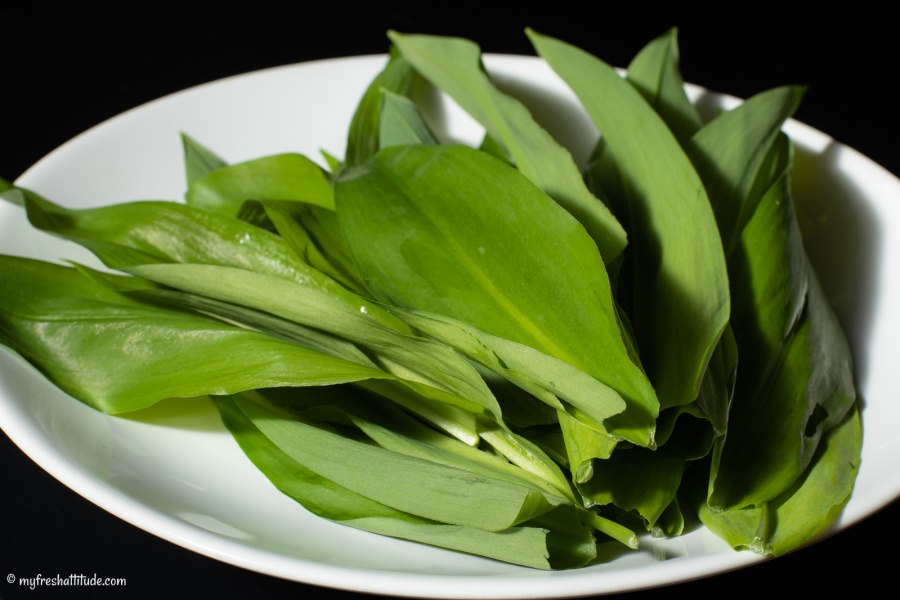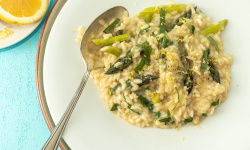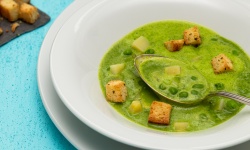
Wild Garlic
My first encounter with wild garlic happened years ago.
I was finishing a rather long hike up and down a small mountain and ending with a hike along a river flowing back into the city. It was early spring and an unusually warm day. It was also one of my first visits to Switzerland. I recently quit my job to begin a career pursuing my new life as a chef. My senses were on high alert. And then we walked into an invisible cloud filled with the unmistakable scent of garlic. “What’s that smell?” I asked my girlfriend (now my wife). “That’s bärlauch” (I found out later it was a kind of wild leek with a garlic aroma). “It’s all over the place…look” as she snapped off a few leaves from the short stems and handed them to me for closer inspection. What an incredible smell – sweet and slightly peppery…and obviously garlic-related. I ate a small sample. It reminded me of chives…or wait a second, maybe that was leeks. It was mild, but with a lingering and definite garlic-ness.
Years later, one of my favorite rituals toward the end of winter is to visit areas where I know wild garlic thrives. I go there just to see if I can catch that first bit of green as it rises from the earth. And when I see it, I smile because I know spring and longer, warmer days are fast approaching. And when I catch that first whiff of garlic in the air, I am immediately transported to that first encounter and hike along the river…of holding hands and falling in love – it is spring!
Wild garlic emerges through the damp soil around forests of deciduous trees or river banks shortly after the majority of winter’s cold temperatures vanish. It is a defining moment of spring’s arrival.
Some say the scent of wild garlic, named bärlauch (bear’s leek) in German-speaking regions, entices hibernating brown bears to wake from their winter slumber and begin to nourish their depleted bodies for a new year. Another claim passed down from the early middle ages, purports the medicinal and strengthening qualities of wild garlic made a person as strong as a bear.
I honestly don’t know about either case, but I can say this, wild garlic is flavorful and flexible in the kitchen. I use it to flavor soups, salads, curry dishes, sauces, oils, dips and even green smoothies. And it is completely free if you live near a patch.
Warning if foraging for wild garlic. There are several important factors you will need to consider when foraging for your own wild garlic. First, always wash wild garlic extremely well in several changes of water to rid the leaves of any potential dried fox excrement. Aside from the fact that munching on anything that has dried dung of any kind on it is not so nice, fox feces often carries tape worm eggs…an unpleasant outcome if you mistakenly eat some. Second, wild garlic looks similar to another plant called Autumn Crocus – a plant that emerges around the same time as wild garlic and looks similar before it blooms much later in the year. The problem is potentially deadly. The leaves of the autumn crocus are toxic – really close to arsenic and potentially just as deadly. Third, there is another plant growing near wild garlic that looks similar. It is called Lily of the Valley. It is not as dangerous as the autumn crocus, but it could lead to severe discomfort and alarming symptoms: a slow heart rate, slight dizziness, throwing up or severe diarrhea.
Here’s what you can do if you are out wandering around and become tempted to forage a bit of wild garlic. Look at the stem of the plant that holds the leaf. Wild garlic stems are always white and always underground. The stems from the lily of the valley are above ground, green at the top end and red at the bottom end. Autumn crocus have larger stems that are grouped – much like a young tulip plant. You can also make a quick inspection of the roots. Autumn crocus have a large onion-like root, lily of the valley have roots that extend horizontal underground and without any onion-like bulge and wild garlic have small onion-like roots. If you are still not 100% sure, then leave the foraging to someone else and get your supply of wild garlic a the nearest farmer’s market.
Season. Young wild garlic is available in early spring. The season will last about 6 weeks, or when the plants begin to flower. The seed pods that appear after the flowering can be harvested and turned into capers (see tips below).
Selecting and Storing. Always look for brightly colored leaves. The under-side of the leaf should be a matte green rather than the glossy-like shine of the top portion. The size of the leaf is irrelevant in terms of flavor – short and long leaves will taste the same. Make sure the leaves are firm-ish without showing any obvious signs of dehydration, such as wilting or becoming quite limp.
Like most leaves, wild garlic will dehydrate quickly and begin to lose their nutrients once they are harvested. Always wash the leaves well (see above warning), then wrap loosely in a paper towel before storing in a breathable bag in your refrigerator. The leaves will last 1-3 days, so be prepared to use them quickly.
Preparing and Cooking. Wild garlic’s distinctive flavor and aroma is most assertive when it is eaten raw. Any kind of cooking will tame the flavor and push the aromas to the background, so be sure to add them toward the end of cooking your risotto, stew or soup. The flavor intensity of wild garlic increases in pungency as the season matures. Then entire plant is edible – use it like you would any fresh herb.
Nutrition. Wild garlic chases the winter away. It has excellent antioxidant properties that have been know for centuries. Herbalists claim wild garlic works against internal infections and may reduce harmful cholesterol.
Maria Treben (1907-1991), one of the most renown herbalists and specialist in traditional herbal medicine, recommends making and consuming wild garlic essence to treat a number of ailments. She recommends filling a small bottle with finely chopped wild garlic leaves and filling it with 40% brandy. The mixture steeps in a warm place for at least two weeks, then strained through a fine sieve and placed in a dark glass bottle. The leaves are discarded. Treben recommended 10-15 drops of the essence 4 times daily to treat anxiety, blood cleansing, diarrhea, poor memory, impure skin, sleep disorder, arteriosclerosis and liver inflammation.
Those are some lofty claims with no scientific backing…but interesting to know I think, because that essence is also really cool to season a soup or sauce.
Jack’s Fresh Tip

To make wild garlic capers, gather some wild garlic when the flowers begin to fall. Remove the seed pods from the stems and wash well. Make a brine by combining 250ml (one cup)water with 2 tablespoons sea salt. Bring the brine to a boil, making sure to keep stirring the mix until the salt dissolves. Place the washed seed pods into a sterilized jar and pour your brine over the seed pods, making sure they all remain under the surface. Cover the jar and leave at room temperature for 5 days. Drain and rinse the wild garlic pods, then place in a smaller sterilized jar. Cover in a mixture of 2/3 apple cider vinegar and 1/3 water. Cover and refrigerate up to 3-6 months.
References
- Die Jahreszeiten-Küche – Gemüse, Susanna Krebs und Hildegard Loretan
- Das grosse Buch vom Gemüse, Teubner
Recipes with Wild Garlic

Tabbouleh
5 0
Swiss Omelette with Wild Garlic
6 0
Lemon Risotto, Asparagus and Wild Garlic
3 2
There are no comments